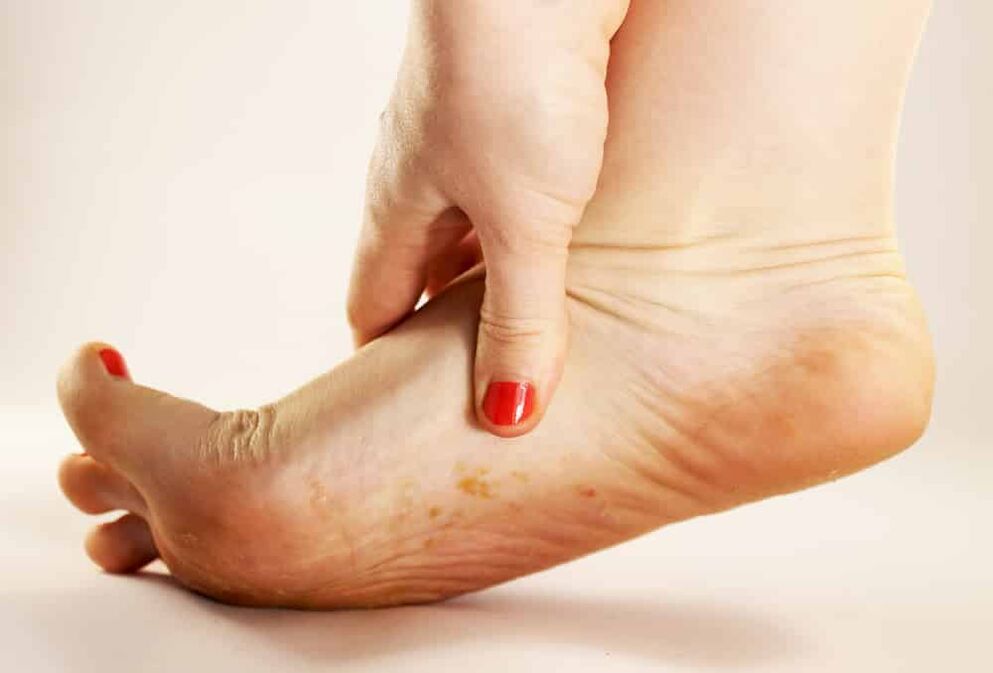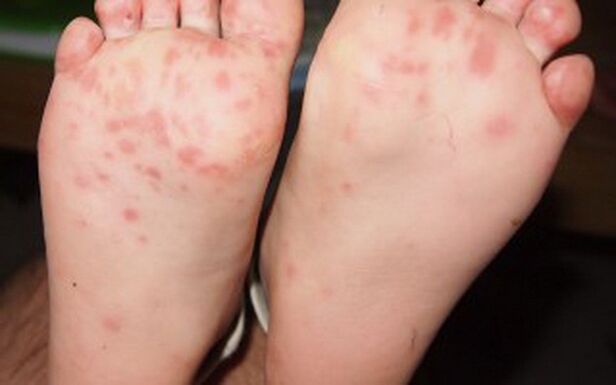“How to cure athlete’s foot”, “How to get rid of onychomycosis, athlete’s foot, quickly, achieve eternal youth and defeat death.”These are all questions on the same level.Athlete's foot cannot be cured quickly and reliably, especially with home methods.You still need a dermatologist.
Mycosis of the foot is a skin disease caused by the spread of parasitic fungi and is one of the most common diseases of human skin (photo).
The disease is quite difficult to treat and leads to complications as it rarely starts on time.

Often a person infected with a fungal infection does not pay attention to the symptoms and the bacteria manage to attach themselves quite firmly to the skin.
Causes of athlete's foot
The high prevalence of foot mycoses is explained by the fact that the disease can be easily transmitted from person to person at the household contact level.
Pathogenic microorganisms “love” a moist and warm environment, which promotes the growth of fungi.
Swimming pools, gyms, spas and saunas - where you can step on the floor barefoot - are among the first places you can catch fungi.
The use of household items and personal items of a person with foot mycosis (towels, washcloths) inevitably leads to infection.
The second reason for the spread of a fungal infection and the formation of foot mycosis is non-compliance with personal hygiene rules and excessive sweating of the feet.
Even changing your socks infrequently and putting them on when your feet are wet creates all the favorable conditions for the growth of fungi on your feet.
Symptoms of athlete's foot
There are different forms of foot mycosis, the symptoms of which have characteristic features.
Erased form of athlete's foot
The symptoms of this form of foot mycosis are insignificant and this is the insidiousness of the skin disease.
A slight dryness and peeling of the dermis is accepted by humans as a completely normal physiological phenomenon.
Although gaps between fingers are considered diaper rash, they are actually symptoms of a fungal infection.
Squamous cell carcinoma-hyperkeratic form of athlete's foot
The most common form of athlete's foot in the population over 60 years of age is moccasin foot.
The name is given because of the obvious visible signs on the surface of the foot:
- thickened, rough skin over the entire surface;
- cracks, calluses (hyperkeratosis);
- Attachment of nail plate lesions;
- Color dirty gray, with a yellowish tint;
- unpleasant smell;
- separation of the stratum corneum, scales;
- Pain when walking and inability to wear shoes.
Vesicular form of athlete's foot
Foot mycoses are known as the wet form of a fungal infection and their symptoms appear in the form of blisters with a thick horny coating.

The blisters that appear eventually open and resemble eczema, ulcers and psoriasis.
In general, athlete's foot manifests itself in different ways.
The disease may begin with cracks in the heels, the formation of bursting and itchy blisters, severe diaper rash, or rough skin.
The peeling of the skin as it peels off the foot in large or small flakes should not go unnoticed.
In addition, there is an unpleasant smell, the feet sweat quickly and the feet “burn” and itch after wearing the shoes.
Complications arising from negligent handling of the symptoms of the disease manifest themselves in the form of erosions and painful wounds on the legs, which sometimes cannot be completely healed.
Treatment of athlete's foot
New generation antifungal drugs are used to treat foot mycoses.They are not so harmful to the liver and show noticeable effectiveness.
However, the fungus is also insidious as it quickly develops resistance to various medications and thus causes relapses.
To cure a fungal infection of the foot, an accurate diagnosis is required, during which it is determined what type of mycosis has spread to the skin.To do this, scrape for mushrooms.
Complex treatment with an accurate drug regimen, both local and systemic, should only be determined by a specialist, since self-medication leads to an exacerbation of the problem.
And the third point of successful treatment is the patient's strict discipline in taking medications, adhering to a diet and taking preventive measures.
For mycosis of the foot, different treatment regimens are used - combination and monotherapy.
And when a drug is selected for monotherapy, it is often for external use.
The combined scheme includes several areas of treatment at once:
- external agents;
- tablets for internal use;
- laser exposure;
- Hardware pedicure
External remedies for athlete's foot
The most effective substance that can affect the fungus is a substance that destroys both mold and yeast-like fungi and can fight dermatophytes and infections of non-fungal origin, which are often associated with foot mycoses.
This substance can be presented in different forms – spray, cream or gel, solution, etc.
The products work on the principle of forming a protective film that can remain on the surface of the skin for up to 72 hours.
External preparations are used in the amount prescribed by the doctor, but often the procedure is carried out 1-2 times a day for 2 to 4 weeks, then treatment continues, but according to a different scheme.
Clean the foot before applying ointment or cream.
They make packs with salicylic acid to remove the callous layer, soap and soda baths, and use petroleum jelly-based ointments to soften and remove dead tissue.
Such procedures are carried out in special rooms for therapeutic pedicure using grinding attachments.
Before treating wet-type foot mycosis, you should dry the ulcers and blisters with boric acid, brilliant green or iodine.
To prevent the spread of the fungus to the nail plates, special varnishes for onychomycosis are prescribed.
However, with the vesicular form of mycosis, corticosteroids must be added to the treatment regimen.
How to cure athlete's foot - systemic therapy
Oral use of antifungals is not indicated for all patients with foot mycoses.
The drugs are quite toxic and therefore are not prescribed to pregnant and lactating women, young children, the elderly and people with impaired liver function.
Taking antifungal drugs in tablet form is carried out according to the instructions accompanying the medicine or according to the scheme prescribed by the doctor.
Recently, drugs have proven themselves that eliminate foot and nail fungus in one go and relieve itching, peeling and irritation of the skin of the feet after the first application.
Folk remedies for the treatment of athlete's foot
If there are categorical contraindications to drug treatment of foot mycoses, you can try folk remedies.
How to cure athlete's foot at home:
- The acid (9%) contained in wine vinegar or table vinegar is an effective folk remedy against fungi.The surface of the skin affected by mycoses is lubricated with it and cotton socks are put over it.Leave it overnight.It is not recommended to use vinegar on wounds or ulcers on the feet.In this case, it is better to reduce the concentration of the folk remedy or replace it with a more gentle one.
- Brewed coffee shows good results.It is necessary to brew the drink stronger and so strong that you can completely immerse your feet in it.For prevention, folk treatment is carried out on two limbs at the same time, even if only one mycosis is observed.Carry out the procedure before bedtime.
- Foot baths made from celandine are also an effective folk remedy that can rid the feet of fungus within a month.Prepare a bath with an amount of 4 tbsp.l per 1 l.Water.The cabbage is boiled, then the legs are steamed in the warm mixture for up to half an hour.You can also use a stronger collection of herbs for brewing - oak bark, chamomile, knotweed, sage, eucalyptus and pine needles.All of them have excellent antifungal properties.
- You can also use topical anesthetic lotions by soaking a cotton swab in the medicated solution and applying it to the affected area.The folk remedy quickly relieves the symptoms – pain and itching.
Prevention of athlete's foot
Effective treatment of foot mycosis is possible with the following preventive measures:
- mandatory disinfection of insoles and inner surfaces of shoes, the more often the better.To do this, use special antifungal sprays for shoes or alcohol;
- It is advisable to change the bed linen daily and wash it at high temperatures;
- Disinfect the surface of the bathtub or shower cubicle and also refuse to visit public bathing establishments during the treatment.
- Do not go barefoot in public places and wipe your feet dry before putting on your shoes.
- All family members must treat the fungus at the same time, otherwise someone will constantly become infected;
- Follow a diet - do not eat allergenic foods, smoked foods, canned foods, heavily salted and peppered foods, and sweets.


















